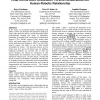CHI
2003
ACM
16 years 24 days ago
2003
ACM
This research investigates the cognitive strategies and eye movements that people use to search for a known item in a hierarchical computer display. Computational cognitive models...
CHI
2003
ACM
16 years 24 days ago
2003
ACM
HCI evaluation methods are useful for improving the design of interactive systems, yet they may be rejected by nontraditional technology disciplines such as media art. We have dev...
100
click to vote
CHI
2003
ACM
16 years 24 days ago
2003
ACM
We developed two visual displays for providing awareness of environmental audio to deaf individuals. Based on fieldwork with deaf and hearing participants, we focused on supportin...
CHI
2003
ACM
16 years 24 days ago
2003
ACM
Texting--using a mobile phone to send text messages--has become a form of mass communication. Building on studies that described how British teenagers have incorporated text messa...
66
Voted
CHI
2003
ACM
16 years 24 days ago
2003
ACM
83
Voted
CHI
2003
ACM
16 years 24 days ago
2003
ACM
Ambiguity is usually considered anathema in Human Computer Interaction. We argue, in contrast, that it is a resource for design that can be used to encourage close personal engage...
82
Voted
CHI
2003
ACM
2003
ACM
Hardware companions?: what online AIBO discussion forums reveal about the human-robotic relationship
16 years 24 days ago
In this study, we investigated people's relationships with AIBO, a robotic pet, through 6,438 spontaneous postings in online AIBO discussion forums. Results showed that AIBO ...
CHI
2003
ACM
16 years 24 days ago
2003
ACM
Kinetic (dynamic) typography has demonstrated the ability to add significant emotive content and appeal to expressive text, allowing some of the qualities normally found in film a...
131
click to vote
CHI
2003
ACM
16 years 24 days ago
2003
ACM
We describe two games in which online participants collaborated with mobile participants on the city streets. In the first, the players were online and professional performers wer...
CHI
2003
ACM
16 years 24 days ago
2003
ACM
We argue that HCI has emerged as a design-oriented field of research, directed at large towards innovation, design, and construction of new kinds of information and interaction te...






